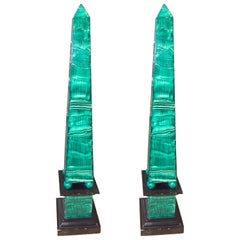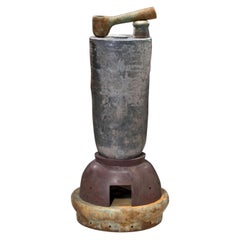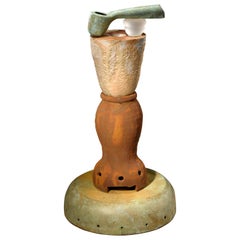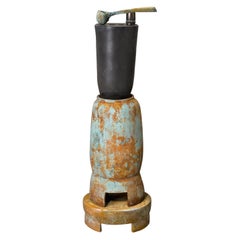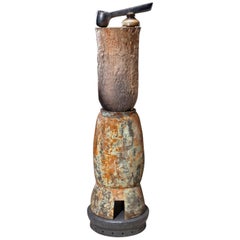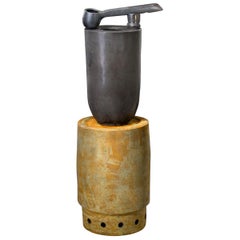Continental US Mounted Objects
to
198
1,110
169
74
246
221
643
243
127
186
146
14
2
14
11
5
16
44
56
28
25
136
133
98
32
31
20
19
12
10
9
5
3
3
2
2
2
1
1
724
529
430
149
127
1,353
1,354
1,022
466
412
387
262
204
Height
to
Width
to
1,353
1,308
1,320
167
25
20
17
15
Item Ships From: Continental US
Pair of Continental Faux Painted Malachite Wooden Pyramids
Located in Southampton, NY
Pair of continental faux painted malachite wooden pyramids.
Category
1920s European Empire Vintage Continental US Mounted Objects
Richard Hirsch Glazed Ceramic Crucible Sculpture #17, 2011
By Richard A. Hirsch
Located in New York, NY
Contemporary American ceramic artist Richard Hirsch Ceramic Crucible Sculpture #17 was made in 2011. It's wheel thrown and hand built clay, wood fire...
Category
21st Century and Contemporary American Modern Continental US Mounted Objects
Materials
Ceramic, Stoneware
Richard Hirsch Glazed Ceramic Crucible Sculpture #32 with Blown Glass, 2016
By Richard A. Hirsch
Located in New York, NY
Contemporary American ceramic artist Richard Hirsch ceramic crucible sculpture #32 was assembled in 2016. It's wheel thrown and hand built clay, anagama wood fired with raku rust pat...
Category
21st Century and Contemporary American Modern Continental US Mounted Objects
Materials
Blown Glass, Ceramic, Stoneware
Richard Hirsch Black Glazed Ceramic Crucible Sculpture #7, 2009
By Richard A. Hirsch
Located in New York, NY
Contemporary American ceramic artist Richard Hirsch Black Ceramic Crucible Sculpture #7 was created in 2009. It's wheel thrown, hand built with black glaze and raku patinas. In the b...
Category
21st Century and Contemporary American Modern Continental US Mounted Objects
Materials
Ceramic, Stoneware
Richard Hirsch Glazed Ceramic Crucible Sculpture #12, 2010
By Richard A. Hirsch
Located in New York, NY
Contemporary American ceramic artist Richard Hirsch Ceramic Crucible Sculpture #12 was made in 2010. It's wheel thrown and hand built, wood fired with raku patinas and black glaze an...
Category
21st Century and Contemporary American Modern Continental US Mounted Objects
Materials
Ceramic, Stoneware
Richard Hirsch Black Glazed Ceramic Crucible Sculpture #4, 2009
By Richard A. Hirsch
Located in New York, NY
Contemporary American ceramic artist Richard Hirsch Ceramic Crucible Sculpture #4 was created in 2009. It's wheel thrown, hand built with black glaze and raku patinas. In the book "W...
Category
21st Century and Contemporary American Modern Continental US Mounted Objects
Materials
Ceramic, Stoneware
Richard Hirsch and Ken Baskin Ladle Presentation Sculpture, 2011
By Ken Baskin, Richard A. Hirsch
Located in New York, NY
Contemporary American ceramic artists Richard Hirsch and Ken Baskin Ladle Presentation Sculpture was created in 2011. This piece is made of soda fired stoneware, saggar fired brick and steel. In the book "With Fire: Richard Hirsch, A Life Between Chance and Design" written by Scott Meyer, Ken Baskin said; "Working collaboratively is based upon a spirit of dedication and generosity, excellent communication, similar levels of ability and an alignment of passion and vision. Most importantly, the group must have mutual trust and respect. Without question, we all hold each other in the highest esteem. I have the utmost respect for everyone involved in The Crucible Project." This sculpture is signed by both artists and ships directly from the Crucible Show inventory located in Montevello, Al.
(Literature: "With Fire: Richard Hirsch, A Life Between Chance and Design", Scott Meyer (Author), RIT Cary Graphic Arts Press 2012 - "Outside In, Collaboration" pgs. 106 - 121 / "Ladle Presentation" pictured on pg. 119)
Richard Hirsch Brief Bio:
In the field of contemporary ceramic, Rick Hirsch has earned an international reputation. He has achieved this recognition by engaging in numerous diversified professional activities. Through efforts in university teaching, exhibits, writing, lecturing and researching he has risen to worldwide prominence.
In 1975, Hirsch co-authored a book entitled Raku, published by Watson-Guptill. This was the first comprehensive text to address the new innovations developing in the west that were transforming traditional Japanese Raku. Also, in the same year, Hirsch became a founding faculty member of The Program in Artistry at Boston University. Currently, Hirsch is a Professor Emeritus at The School for American Crafts which is a part of Rochester Institute of Technology in Rochester, NY. His university teaching career now spans well over four decades.
Repeatedly, Hirsch has participated in several milestone exhibitions and publications. Significant shows include; The Evolution of American Art in Craft Media Since 1945; Echoes: Historical References in Contemporary Ceramics; American Ceramics Now; Raku: Origins, Impact and Contemporary Expression; and Convergences: The Presence of the Past in Contemporary American Ceramics.
Frequently his work appears in book and magazine publications, such as; Overseas Contemporary Ceramic Art Classics by Baiming, China; Raku Investigations into Fire by David Jones, England; The History of American Ceramics from 1607 to the Present by Elaine Levin, New York; World Contemporary Ceramics by Baiming, China; and Firing, Philosophies within Contemporary Ceramic Practice by David Jones, England.
Several museums have included his work for their permanent collections. These include; The Carnegie Museum of Art, Pittsburgh; The Renwick Gallery, Smithsonian Institute, Washington DC; The High Museum of Art, Atlanta; The Everson Museum of Art, Syracuse; The Nelson-Atkins Museum of Art, Kansas City, Missouri; The Taipei County Yinko Ceramics Museum, Taipei, Taiwan; and the George R. Gardiner Museum of Ceramic Art, Toronto, Canada.
In 1984, Hirsch was elected as a permanent member of The International Ceramics Academy, a worldwide organization headquartered in Geneva, Switzerland. A recipient of a William J. Fulbright Research Scholar Award in 2002, Hirsch has also received several Individual Artists Grants. Most recently he was honored by The Rochester Institute of Technology, with the Board of Trustees' Outstanding Scholarship Award. Recently Hirsch collaborated with Dr. Scott Meyer on his biography, the book is entitled With Fire: Richard Hirsch and is published by The Cary Graphic Arts Press at RIT, ISBN-13: 978-1-933360-97-3.
Amid the ever-shifting sands of change and new trends that is prevalent in contemporary ceramics, Richard Hirsch has maintained his steadfast personal aesthetic and continues to make a significant contribution to his field.
Ken Baskin Brief Bio:
Kenneth Baskin received his BFA from College for Creative Studies in Detroit, Michigan and earned his MFA from University of South Carolina. Presently he holds the position of Associate Professor of Art/Ceramics at McNeese State University in Lake Charles, Louisiana.
In 2007 Baskin was honored as one of the recipients of one of the National Council on Education in the Ceramic Arts (NCECA) Emerging Artist Awards. Recently he was honored by being selected for a solo exhibition of his ceramic sculptures at the Taipei County Yingge Ceramics Museum, Taipei, Taiwan; in conjunction with this exhibition he was also invited as a visiting artist, workshop instructor and lecturer at: Tainan National University of the Arts in Tainan, Taiwan and National Taiwan University of the Arts in Taipei. Baskin’s work has also been included in numerous group and solo exhibitions both nationally and internationally. Baskin’s creative research was the topic for an essay titled “20th Century...
Category
21st Century and Contemporary American Modern Continental US Mounted Objects
Materials
Steel
Large Marble Obelisk with Brass Mount
Located in Los Angeles, CA
A hand carved, beautifully veined solid, polished marble obelisk mounted on a polished brass base.
Category
19th Century European Antique Continental US Mounted Objects
Materials
Marble, Brass
Assemblage #30
Located in Sagaponack, NY
An industrial assemblage by WYETH's creator John Birch featuring a mechanical vice and industrial tools on a leather base.
Category
2010s Industrial Continental US Mounted Objects
Materials
Metal
$3,800
Pair of 18th Century Italian Giltwood Fragment Garniture
Located in Los Angeles, CA
Ostrich egg is 5.5" w. No cracks or repairs.
Category
18th Century Italian Neoclassical Antique Continental US Mounted Objects
Materials
Ostrich Eggshell, Giltwood
18th Century Giltwood Sculpture of a Female Nude
By Michelangelo Buonarroti
Located in New York, NY
This giltwood sculpture was carved in the round, probably in southern France or northern Italy in the 1760s. Her pronounced musculature speaks to the ongoing influence of Michelange...
Category
Mid-18th Century French Neoclassical Antique Continental US Mounted Objects
Materials
Bronze
Tabletop Sculpture from USA
Located in Sagaponack, NY
A metal sculpture consisting of a thin rigid wire with folded, fortune-cookie-shape pieces of naturally patinated brass slipped onto the rod and stacked vertically. The rod is set in...
Category
1970s American Vintage Continental US Mounted Objects
Materials
Brass
Contemporary Propeller Sculpture by Kcho
By KCHO (Alexis Leyva Machado)
Located in North Miami, FL
Contemporary metal and glass with rubber tire, wood and metal propeller by artist Kcho. Kcho is a contemporary Cuban artist working in sculpture and mi...
Category
21st Century and Contemporary Continental US Mounted Objects
Materials
Metal
Hand Carved Stone Mask, China, Contemporary
Located in New York, NY
Contemporary Chinese hand carved stone mask on metal stand.
Stand measures 4 x 3.
Sits nicely with two blue/grey/black discs (S6769).
Category
21st Century and Contemporary Chinese Continental US Mounted Objects
Materials
Stone
Jeff Koons “Lips” Porcelain Plate
By Jeff Koons
Located in Lake Worth Beach, FL
Artist/Designer: Jeff Koons (American, b. 1955); Bernardaud
Additional Information: The coupe service plate was produced in honor of Bernardaud’s 150th anniversary. The original pai...
Category
2010s French Continental US Mounted Objects
Materials
Porcelain
Glass Sculpture of a Scorpion
Located in West Palm Beach, FL
A fascinating glass figure of a scorpion
Signed.
Designed as a scorpion with a metal and marble stand
Measures: Height 26 in., (66.04 cm.), width 10 1/2 in., (26.67 cm.), depth 6 ...
Category
20th Century Continental US Mounted Objects
Materials
Glass
One Pair of Charming Wooden Shoe Moulds Mounted as Bookends Great Character.
Located in Buchanan, MI
One pair of charming wooden shoe moulds mounted as bookends, comes with four leather bound books. Feel free to call with further questions. Would look great in a private library
Category
19th Century American Folk Art Antique Continental US Mounted Objects
Materials
Steel
Pair of Deco Modern Spears, Polished Nickel, Rock Crystal, Marble
By Murano 5
Located in Los Angeles, CA
Pair of Deco Modern Spears, Polished Nickel Rock Crystal, Black Marble base. Rock, Crystal is from Brazil. One of a kind decorations .
Category
20th Century Unknown Art Deco Continental US Mounted Objects
Materials
Rock Crystal, Marble, Nickel
Ed Stertz Salmon Marble Table Sculpture
Located in Brooklyn, NY
An interesting stone sculpture that is mounted to a swiveling base. The marble's unique form and naturally salmon pink color make for an eye-catching decoration in any room. Please c...
Category
Mid-20th Century Mid-Century Modern Continental US Mounted Objects
Materials
Stone
$665 Sale Price
30% Off
Arango & Lollar, Temple of Vesta Rome, Iron & Welded Steel Sculpture, US
By Ricardo Arango, Thomas W. Lollar
Located in New York, NY
Thomas Lollar earned his BFA and MA at Western Michigan University, and has been teaching ceramics and sculpture since 1975. A master sculptor, his subjects are rendered in both fron...
Category
2010s American Continental US Mounted Objects
Materials
Steel, Iron
Abstract Sculpture by Lucile Driskell Resembling a Greek Key
Located in Stamford, CT
A silver plated abstract sculpture by Lucile Driskell (1924-2017) signed and numbered 1/100.
Category
1980s American Modern Vintage Continental US Mounted Objects
Materials
Marble, Metal
Patinated Metal Tendril Sculpture
Located in Los Angeles, CA
Sitting atop a cubic pedestal, the amorphous tendril combines a soft dimension with a pointed shape. The rust texture highlights the varied facets. The oversized base provides an int...
Category
Mid-20th Century American Modern Continental US Mounted Objects
Materials
Metal
Table Top Sculpture by John Steck
By John Steck
Located in Sagaponack, NY
From Steck’s 'Desert Flower’ series, this tabletop sculpture exhibits, per an America House advertisement in Craft Horizons January/February 1965 (which illustrates this sculpture), ...
Category
1960s American Mid-Century Modern Vintage Continental US Mounted Objects
Materials
Stone, Metal
Vincent Pocsik, "Two to Dance", Light Sculptures, 2021
By Vincent Pocsik
Located in Los Angeles, CA
Vincent Pocsik’s sculptural works are a study of human form abstracted down to the point of its most transformative power. Flesh twists, contracts, pushes against bones and skin and ...
Category
21st Century and Contemporary American Continental US Mounted Objects
Materials
Hardwood
19th Century Bronze Doré Byzantine Style Angels on Lucite Stands
Located in Dallas, TX
Pair of bronze doré Byzantine style angels with original green color over bronze on the wings. Mounted on lucite stands.
Category
19th Century European Antique Continental US Mounted Objects
Materials
Bronze
Opening, US
By Mindy Horn
Located in New York, NY
Several themes appear often in Horn’s work, the most central being multiplicity.
Horn’s meticulously constructed wall reliefs are composed of minuscule, seemingly identical pieces...
Category
2010s American Modern Continental US Mounted Objects
Materials
Gold
Price Upon Request
Reflection, US
By Mindy Horn
Located in New York, NY
Several themes appear often in Horn’s work, the most central being multiplicity.
Horn’s meticulously constructed wall reliefs are composed of minuscule, seemingly identical pieces...
Category
2010s American Modern Continental US Mounted Objects
Materials
Gold
Price Upon Request
Parterre 'Triptych', US
By Mindy Horn
Located in New York, NY
Several themes appear often in Horn’s work, the most central being multiplicity.
Horn’s meticulously constructed wall reliefs are composed of minuscule, seemingly identical pieces...
Category
2010s American Modern Continental US Mounted Objects
Materials
Gold
Price Upon Request
Still Life, US
By Mindy Horn
Located in New York, NY
Todd Merrill Studio has represented Mindy Horn since 2019. Horn believes that a life, an idea, or a work of art all begin with perfection, or as she puts it “an untested plan of what...
Category
2010s American Modern Continental US Mounted Objects
Materials
Gold
Price Upon Request
Garden Tondo, US
By Mindy Horn
Located in New York, NY
Mindy Horn’s ceramic “Garden Tondo” revisits elements most often seen in her vessels, which are notable for their imperfections, appearing to have grown and then weathered organically. With her most recent ceramic wall medallion, a multitude of individual floral specimens converge into an unexpected baroque composition. Each tiny, hand-formed component’s individuality is lost within the larger picture. Incorporating subtle variations in the treatment of the delicate porcelain pieces, such as glazing, bisque firing, the application of powdery mason stain, or firing with a gold luster overglaze, creates a complex, glimmering landscape across the surface. Similarly, the lifting of each tiny composition off of the solid...
Category
2010s American Modern Continental US Mounted Objects
Materials
Gold
Price Upon Request
An Exquisite and Rare French Louis XVI Style Ormolu-Mounted Bloodstone Inkwell
Located in Queens, NY
An Exquisite and Rare French Louis XVI Style Ormolu-Mounted Bloodstone Inkwell, circa 1875.
A truly exceptional and jewel like quality inkwell encrier, made with the finest ormolu, mounted on bloodstone. A true collectors and one of a kind piece.
Revival of the ancient régime in the late 19th century was paramount to the French furniture and bronze casting firms of the Belle Epoque. Imitation in the highest regard and replication of those tastes and styles was prevalent throughout the Paris Faubourg, where the most talented bronziers and ébénistes established their workshops. The present inkwell encrier recalls the late 18th century's obsession with hardstones - a taste expounded above all by the duc d'Aumont and, subsequently Marie-Antoinette. Such hardstone-mounted pieces, reminiscent of Renaissance schatzkammer objects, enjoyed a revived popularity at the end of the 18th century through the impetus of both the marchands-mercier and, more importantly, the hôtel des Menus-Plaisirs, where the duc d'Aumont himself established a workshop in 1770 specializing in the cutting and polishing of precious hardstones.
This exceptional inkwell encrier, sumptuously-mounted with finely chased gilt-bronzes, incorporates a highly-prized material such as bloodstone.
Sometimes called the Sunstone, the meaning of Bloodstone comes entangled in fascinating history. The Ancient Greeks held the Bloodstone as a gem with glorious powers. They referred to it as Heliotrope, which directly translates to Sunstone. It was believed to have heavenly healing powers gifted by the gods and most certainly when it came to healing all things related to the blood. Even as we move forward into the Middle Ages, the Bloodstone takes another mystical story under its wing. It was believed to be formed from Christ's blood. It was said that during the Crucifixion, a few red spots of his blood dripped...
Category
19th Century French Napoleon III Antique Continental US Mounted Objects
Materials
Bronze, Ormolu
Mellerio Paris, A French Gold, Diamonds, Silver, and Smoky Quartz Carved Horse
By Mellerio
Located in Queens, NY
Mellerio Paris, A French Gold, Diamonds, Silver-Gilt, Rock-Crystal, Jade, Mother-Of-Pearl and Smoky Quartz, Carved Horse Sculpture, Jeweled Mounted Object.
An extremely rare and unique, one of a kind French gold, diamonds, Silver-gilt, rock-crystal, jade, obsidian, mother-of-pearl, and smoky quartz carved jeweled sculpture "CHEVAUX DE LEGENDE", "A Legendary Horse" by Mellerio, Paris, circa 1991.
Sitting on black obsidian base, the solid rock-crystal slab is finely applied with a carved smoky -quartz and jade horse with a harness mounted in 18k gold, brilliant -cut diamonds, rubies, turquoise, and amethyst chains and pendants. The top columns adorned with 18k gold and brilliant cut diamond pendants, the bottom with gold and mother of pearl plaques. The obsidian base with a plaque engraved: CHEVAUX DE LEGENDE" / N° 05 / MELLERIO DITS MELLER / PARIS / 5003 D
The piece is in excellent condition and comes with a custom made wood case made for transport. It's very elegant and has French hallmarks throughout. A truly magnificent piece.
Measures 10.5" high x 8.5" wide x 4" deep
Founded in France in 1613 by the descendants of Italian immigrants from the Vigezzo Valley in the north of Italy, Mellerio is one of the oldest jewellery houses in Europe. The family business soon attracted the attention of the Royal Court and Marie Antoinette herself reportedly purchased a precious bracelet featuring 7 cameos surrounded by rubies in 1780. Later on, in the 19th century, Mellerio became the official supplier of the French Royal family and the Court of Netherland.
Mellerio creates many jewellery items, all set with rare gems such as peridots, amethysts, aquamarines, citrines and topaz, applying for a patent, the flexible stem, a very supple and light jewellery mechanism. Mellerio remains also well known for their spectacular series of Art Nouveau jewels, created at the beginning of the 20th century, as well as for the creation of trophies rewarding some of the greatest footfall and tennis players of history. In 1993, the jewellery house launched their first watch collection.
Today, Mellerio has stores in Paris, Japan and Hong Kong.
July 14, 1789: this date is known throughout the world as the beginning of the French Revolution. According to a ledger belonging to House of Mellerio, this was also the day that the jeweler sold a golden key to the Comte de Coutance for 10 livres. This ledger, as well as inventories dating as far back as 1768, are the jeweler’s oldest archives. These archives have continued to grow over the years, as the House, established on rue de la Paix in Paris, still lives on today, still in the hands of the same family from Craveggia, in the North of Italy.
The tumultuous history of the Mellerio family in France probably goes as far back as the Italian wars of the Renaissance, but the first official document proving their commercial activity in Paris dates back to 1613. This document is the famous royal warrant awarded by Marie de Medici to a number of Italian families established along the rue des Lombards, including the Mellerios, allowing them to sell “small jewelery items”, therefore granting them a small exception to the traditional monopoly enjoyed by Parisian jewelers. At that time, powerful corporations regulated the operations and customs of Parisian business, but thanks to this exceptional warrant, the Mellerios managed to escape the confines of this framework. Today, this wax-sealed document is kept at the city hall of Craveggia.
From 1613 to the Revolution, the Mellerios lived between France and Italy. The corporations tried many times to put an end to their trade privileges, but all in vain, as a dynasty of sovereigns renewed the warrant. Always marrying and often retiring in Craveggia, the Mellerios continued to maintain their jewelry business in Paris. At first, they did this without a shop. Wearing backpacks (wooden boxes divided into small compartments where jewels were kept), they would tour town fairs around Paris and royal castles.
This is how Jean-Baptiste Mellerio (1765-1850) is said to have sold a bracelet set with rubies and Antique cameos to Marie-Antoinette, which still exists today. Many elements seem to prove the veracity of this anecdote. The queen was particularly fond of cameos, which cover the entire background of her famous jewelry cabinet, and ruby was her favorite stone after diamond. The famous bracelet, reacquired a few years ago by the House of Mellerio, is indeed an 18th century jewel, set with antique cameos representing the profiles of Roman emperors. Two branches of the family were operating in Paris during this time, under the reign of Louis XVI: that of Jean-François (1746-1828), the paternal ancestor of the current Mellerios, and that of Jean-Baptiste (1765-1850).
The French Revolution forced them to return to Italy. However, both Jean-Baptiste and François Mellerio (1772-1843), who was the son of Jean-François, were eventually able to return to Paris after the founding of the Consulate. Jean-Baptiste opened a shop at the Iron Crown of rue Vivienne, and François opened his at the Palais des Tuileries, rue du Coq Saint-Honoré. His well-organized order books give an idea of his high-ranking clientele during the “Old Regime”, among which were the Comte and Comtesse Octave de Segur, the Marquise (later Duchess) de Tourzel, former governess of the royal children, and her daughter, the Comtesse de Bearn, the Craufurds -who organized the flight to Varennes, the Duc and Duchess de Gramont, the Comtesse de Boigne, and Madame de Souza, Talleyrand’s mistress.
We also see the names of the imperial family: Empress Josephine, the Queen of Holland, Princess Elisa, Caroline and Pauline. At that time, the House of Mellerio specialized, among other things, in the trade of antique cameos, a newly fashionable genre of jewel that captured the imagination of all the princesses and noble women of the time.
The years of the Restauration and July Monarchy were among the most glorious. The Bourbons were back on the throne, and the clientele of the House of Mellerio had regained its former wealth. Mellerio supplied Louis-Philippe, Duke of Orléans, as well as his mother, wife and sister, with sumptuous jewels, including a set of emeralds made piece by piece, while the Duke of Bourbon, last prince of the House of Condé, offered diamonds to his mistress, the scheming Baronne de Feucheres, and Monsieur de LaFayette also bought cameos for one of his granddaughters. For the first time, Mellerio ventured into the world of arts in 1815, when Carlotta Grisi, a famous dancer who created Giselle, as well as an actress named Rachel, bought jewels at the Mellerio store on rue de la Paix.
1848 marked a new turning point. France once again became a Republic. François Mellerio handed the company over to his son, Jean, and the latter decided to travel to Spain to build a new clientele. He later became one of the jewelers of the royal family, and met Eugénie de Montijo, who remained a faithful client when she became empress of the French people. The Imperial years were lavish. During the Second Empire, Paris was a pageant of crinoline dresses designed by Worth, while jewels by Mellerio, Worth’s neighbour on the rue de la Paix, adorned the noble women of the Tuileries court.
The Empress bought pearls. Mathilde Bonaparte...
Category
20th Century French Continental US Mounted Objects
Materials
Rock Crystal, Jade, Quartz, Gold, Silver
Mellerio Paris, A French Gold, Diamond, Silver-Gilt, Rock-Crystal, & Lapis Horse
By Mellerio
Located in Queens, NY
Mellerio Paris, A French Gold, Diamond, Silver-Gilt, Rock-Crystal, Obsidian & Lapis Horse
An extremely rare and unique, one of a kind French gold, diamonds, Silver-gilt rock-crystal, obsidian and lapis lazuli jeweled sculpture "Bucéphale, Chevaux de légende", "Bucephalus, A Legendary Horse" by Mellerio, Paris, circa 1998.
Sitting on black obsidian base, the solid rock crystal slab is finely applied with a lapis lazuli half-horse with harness mounted in 18k gold and brilliant cut diamonds, between two crystal and lapis lazuli columns adorned with gold and diamonds, insert with 7 ruby cabochons and 1 emerald cabochon, the obsidian base with a plaque engraved: CHEVAUX DE LEGENDE / MELLERIO DITS MELLER / PARIS / 5029 DIV
Bucephalus (c355-326 BC) is among the most famous horses in history, and it was said that this he could not be tamed. The young Alexander the Great, of course, tamed him – and went on to ride his beloved equine companion for many years and into many battles.
The piece is in excellent condition and comes with a custom made wood case made for transport. It's very elegant and has French hallmarks throughout. A truly magnificent piece.
Measures 10" high x 9" wide x 4" deep
Founded in France in 1613 by the descendants of Italian immigrants from the Vigezzo Valley in the north of Italy, Mellerio is one of the oldest jewellery houses in Europe. The family business soon attracted the attention of the Royal Court and Marie Antoinette herself reportedly purchased a precious bracelet featuring 7 cameos surrounded by rubies in 1780. Later on, in the 19th century, Mellerio became the official supplier of the French Royal family and the Court of Netherland.
Mellerio creates many jewellery items, all set with rare gems such as peridots, amethysts, aquamarines, citrines and topaz, applying for a patent, the flexible stem, a very supple and light jewellery mechanism. Mellerio remains also well known for their spectacular series of Art Nouveau jewels, created at the beginning of the 20th century, as well as for the creation of trophies rewarding some of the greatest footfall and tennis players of history. In 1993, the jewellery house launched their first watch collection.
Today, Mellerio has stores in Paris, Japan and Hong Kong.
July 14, 1789: this date is known throughout the world as the beginning of the French Revolution. According to a ledger belonging to House of Mellerio, this was also the day that the jeweler sold a golden key to the Comte de Coutance for 10 livres. This ledger, as well as inventories dating as far back as 1768, are the jeweler’s oldest archives. These archives have continued to grow over the years, as the House, established on rue de la Paix in Paris, still lives on today, still in the hands of the same family from Craveggia, in the North of Italy.
The tumultuous history of the Mellerio family in France probably goes as far back as the Italian wars of the Renaissance, but the first official document proving their commercial activity in Paris dates back to 1613. This document is the famous royal warrant awarded by Marie de Medici to a number of Italian families established along the rue des Lombards, including the Mellerios, allowing them to sell “small jewelery items”, therefore granting them a small exception to the traditional monopoly enjoyed by Parisian jewelers. At that time, powerful corporations regulated the operations and customs of Parisian business, but thanks to this exceptional warrant, the Mellerios managed to escape the confines of this framework. Today, this wax-sealed document is kept at the city hall of Craveggia.
From 1613 to the Revolution, the Mellerios lived between France and Italy. The corporations tried many times to put an end to their trade privileges, but all in vain, as a dynasty of sovereigns renewed the warrant. Always marrying and often retiring in Craveggia, the Mellerios continued to maintain their jewelry business in Paris. At first, they did this without a shop. Wearing backpacks (wooden boxes divided into small compartments where jewels were kept), they would tour town fairs around Paris and royal castles.
This is how Jean-Baptiste Mellerio (1765-1850) is said to have sold a bracelet set with rubies and Antique cameos to Marie-Antoinette, which still exists today. Many elements seem to prove the veracity of this anecdote. The queen was particularly fond of cameos, which cover the entire background of her famous jewelry cabinet, and ruby was her favorite stone after diamond. The famous bracelet, reacquired a few years ago by the House of Mellerio, is indeed an 18th century jewel, set with antique cameos representing the profiles of Roman emperors. Two branches of the family were operating in Paris during this time, under the reign of Louis XVI: that of Jean-François (1746-1828), the paternal ancestor of the current Mellerios, and that of Jean-Baptiste (1765-1850).
The French Revolution forced them to return to Italy. However, both Jean-Baptiste and François Mellerio (1772-1843), who was the son of Jean-François, were eventually able to return to Paris after the founding of the Consulate. Jean-Baptiste opened a shop at the Iron Crown of rue Vivienne, and François opened his at the Palais des Tuileries, rue du Coq Saint-Honoré. His well-organized order books give an idea of his high-ranking clientele during the “Old Regime”, among which were the Comte and Comtesse Octave de Segur, the Marquise (later Duchess) de Tourzel, former governess of the royal children, and her daughter, the Comtesse de Bearn, the Craufurds -who organized the flight to Varennes, the Duc and Duchess de Gramont, the Comtesse de Boigne, and Madame de Souza, Talleyrand’s mistress.
We also see the names of the imperial family: Empress Josephine, the Queen of Holland, Princess Elisa, Caroline and Pauline. At that time, the House of Mellerio specialized, among other things, in the trade of antique cameos, a newly fashionable genre of jewel that captured the imagination of all the princesses and noble women of the time.
The years of the Restauration and July Monarchy were among the most glorious. The Bourbons were back on the throne, and the clientele of the House of Mellerio had regained its former wealth. Mellerio supplied Louis-Philippe, Duke of Orléans, as well as his mother, wife and sister, with sumptuous jewels, including a set of emeralds made piece by piece, while the Duke of Bourbon, last prince of the House of Condé, offered diamonds to his mistress, the scheming Baronne de Feucheres, and Monsieur de LaFayette also bought cameos for one of his granddaughters. For the first time, Mellerio ventured into the world of arts in 1815, when Carlotta Grisi, a famous dancer who created Giselle, as well as an actress named Rachel, bought jewels at the Mellerio store on rue de la Paix.
1848 marked a new turning point. France once again became a Republic. François Mellerio handed the company over to his son, Jean, and the latter decided to travel to Spain to build a new clientele. He later became one of the jewelers of the royal family, and met Eugénie de Montijo, who remained a faithful client when she became empress of the French people. The Imperial years were lavish. During the Second Empire, Paris was a pageant of crinoline dresses designed by Worth, while jewels by Mellerio, Worth’s neighbour on the rue de la Paix, adorned the noble women of the Tuileries court.
The Empress bought pearls. Mathilde Bonaparte...
Category
20th Century French Continental US Mounted Objects
Materials
Lapis Lazuli, Rock Crystal, Gold, Silver
Recently Viewed
View AllMore Ways To Browse
Vintage Wicker Wine Bottles
Viso Porcelain
Wall Mount Water Fountains
Wedgwood Green Jasperware
Wedgwood Portrait
West German Pot
White Ceramic Garden Stool
White Ironstone China
White Lacquer Bar Cart
Woman With Water Jug
Wooden Chest 1800
Wooden Tea Cart
Worcester Jug
Wrights Antiques
Yellow Lalique Vase
Yves Saint Laurent Lamps
Zani Italian
17th Century Italian Baroque Commode
